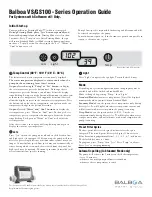
10
Ground Source Heat Pumps Since 1983
2.6. Heating connection
The heating circuit 1 is the main circuit with higher temperature e.g. heating with radiators. The heating circuit 2 is
the secondary circuit with lower temperature e.g underfloor heating.
Pipes in the heating network are connected to the ground source heat pump using either textile hoses (network of
radiators) or using a fixed piping network (floor heating network). These connections stop sound from passing into the
pipes. All heating connections (for example, a heating radiator for an air conditioner or a heated towel rail) must be
made to the heat piping. When the network piping on the is in place, filling may commence. The pipes in the network
are filled with water.
Please note! If renovating, ensure that the heat distribution piping has been properly rinsed before connecting the
heat pump.
Filling a heating system fitted with a pressure gauge:
• open the fill valve on the heating network
• fill the piping with water
• deaerate the piping through the water tank
• fill and deaerate the network until all the air has been removed and leave the pressure at 1–1.2 bar
• maximum values
• heating network 1,5 bar
• DHW network 9 bar
2.7. Domestic water connection and circulation of water
Complete the piping connections according to the piping connections diagram in section 2.2. The circulation water
pump is installed on the input side of the heat pump. The mixing valve is fitted to the hot water pipe in order to prevent
burns.
The overflow pipe is joined to the floor drain as instructed or to an overflow funnel if the distance to the floor drain is
more than two metres. The overflow funnel must be directed down towards the floor drain. The backpressure valve is
fitted to the cold water joint on the input side.
2.8. HEPAC check list
Check that
• the connections are tight and there are no leaking valves
• the expansion tank on the heating system and fill side is properly installed
• the overflow pipe on the shut-off valve and the pressure gauge on the heating system have been properly installed
• the heating system has been filled and deaerated appropriately
• collector pipes has been installed, filled and deaerated appropriately











































